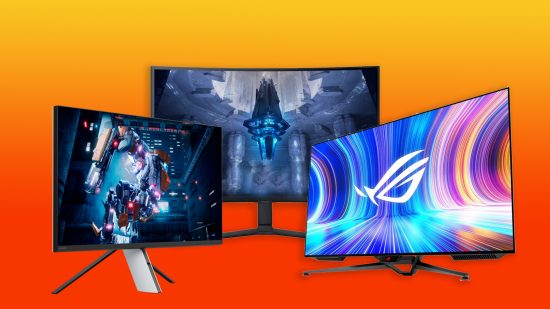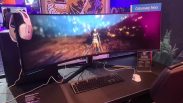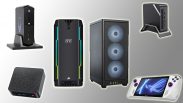What’s the best 4K gaming monitor? We’ve checked out a range of 4K gaming monitors from budget to full-tilt UHD dynamos to find out – keep reading to find out how to pick the perfect screen for you. Ultra High Definition (UHD) 4K gaming monitors have been around since 2012, but the prices were enough to make your eyes bleed. Fortunately, 4K sets are a lot more affordable today.
Why get a 4K gaming monitor? Well, at four times the pixel resolution of a standard HD panel, 4K monitors offer a huge jump in visual performance, delivering sharper, more detailed images. With 4K support becoming the norm for developers, the best 4K gaming monitors can display modern games precisely as they were intended, in all their eye-popping, UHD splendour.
Connectivity is a crucial concern with 4K gaming monitors. Support for standards such as HDMI 2.1 and DisplayPort support means your monitor can access a variety of standards and ultimately connect to more equipment.
Yes, the best 4K gaming monitors will set you back more than the equivalent-sized HD models, but provided you have the necessary graphics firepower with the best graphics cards, you’ll reap the rewards in a vastly more immersive gaming experience.
Beyond gaming, the best 4K gaming monitors also revolutionize your film and TV viewing, and if you absolutely have to use them for work, they can make even the dullest PowerPoint presentation pop. We’ve picked out the best 4K gaming monitors to make the most of your setup. If you don’t need or can’t afford 4K resolution, our guide to the best gaming monitor has more options.
These are the best 4K gaming monitors for 2023:
- Asus ROG Strix XG32UQ – best overall
- Gigabyte M28U – best on a budget
- Sony INZONE M9 – best cross-platform pick
- Dell G3223Q –best all-rounder
- Asus ROG Swift PG42UQ – big 42-inch screen
- Samsung Odyssey Neo G7 – best 43-inch monitor
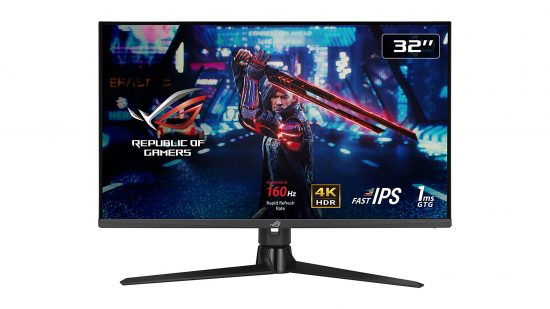
1. Asus ROG Strix XG32UQ
The best 4K gaming monitor overall with fast IPS
Asus ROG Strix XG32UQ specs:
| Screen | 32-inch Fast IPS |
| Refresh rate | 160Hz (overclocked) |
| Connectivity | 2x HDMI 2.1 Display port 1.4 (DSC) 2x USB 3.2 |
| Speakers | No |
| Dimensions w/ stand | 28.66 x 18.1 x 11.02 in (72.8 x 45.97 x 27.99cm) |
| Dimension w/o stand | 28.66 x 16.87 x 3.43 in (72.8 x 42.85 x 8.71 cm) |
| Weight | 19.62 lbs (8.9 kg) |
Pros:
- Impressive 160Hz (overclocked) refresh rate
- G-SYNC and FreeSync Premium Pro compatible
- Vibrant colour reproduction
Cons:
- Not the cheapest
- No USB-C port
- You might need a new graphics card
The Asus ROG Strix XG32UQ, like the rest of the Republic of Gamers line-up, is a no-holds-barred, high-performance gaming powerhouse that crams in a feast of tech, albeit at a premium price point.
This 32-inch 4K Fast IPS gaming monitor features an overclocked 160Hz refresh rate and 1ms response time. It also offers the latest HDMI 2.1 standard, compatible with the current crop of 4K-capable consoles and includes support for both Nvidia’s G-SYNC and AMD’s FreeSync Premium Pro.
As you’d expect from a high-end 4K gaming monitor, the Asus is a looker, although you wouldn’t necessarily know it from the front. The slim bezel with the ROG logo at the bottom of the screen doesn’t give much away, but the etched rear with mirrored ROG logo will have you periodically craning your neck around the back for a quick peek. The stand is reassuringly solid and will tilt and swivel but doesn’t allow for rotation.
As with the other models here, you’ll need a cutting-edge graphics card to power such a high-spec monitor, but with the right hardware in place, visuals are crisp, bright and colours are eye-poppingly vivid. Black levels are good, if not spectacular, but that’s an issue common to IPS monitors and the trade-off for super-wide viewing angles and vibrant colours.
It lacks USB-C support and is on the pricier end of the spectrum, but there are precious few other gripes to level at this monitor. If you’re serious about gaming, the Asus ROG Strix XG32UQ is a fine choice.
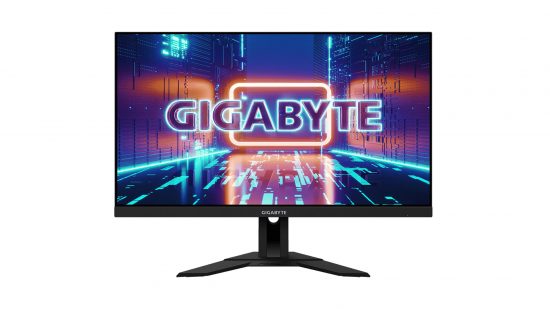
2. Gigabyte M28U
The best budget 4K gaming monitor
Gigabyte M28U specs:
| Screen | 28-inch IPS |
| Refresh rate | 144Hz (120Hz for Console Games) |
| Connectivity | HDMI 2.1 Display port 1.4 (DSC) USB Type-C |
| Speakers | 2x 3 watts |
| Dimensions w/ stand | 25.08 x 21.02 x 7.64 in (63.7 x 53.4 x 19.4 cm) |
| Dimension w/o stand | 25.08 x 14.65 x 2.48 in (63.7 x 37.2 x 6.31 cm) |
| Weight | 15.28 lbs (6.93 kg) |
Pros:
- HDMI 2.1 ports for next-gen console gaming.
- Outstanding response time
- Fast refresh rate
Cons:
- Contrast could be better
- Stand can’t swivel or rotate
- Poor speakers
Gigabyte might not be a household name, but it’s taking the gaming world by storm with a selection of 4K panels in a variety of sizes, from 55-inch down to the 28-inch model we’re focusing our attention on here. The best thing about its products is that they offer big-screen 4K gaming for comparatively little money.
With a fast 144Hz refresh rate and a low input lag of 1ms, things look promising from the get-go. As with all of the screens here, you’ll need to make sure your graphics card is up to the job, as delivering those high frame rates in 4K is no mean feat.
HDMI 2.1 support means the PlayStation 5 and Xbox Series X also get a look-in with 4K at 120Hz on offer. In addition, the M28U also features a USB-C connection to give even more flexibility.
Naturally, something has to give when the price point is this appealing. In the case of the Gigabyte M28U, it’s in the style stakes that things slide a little. It’s no car crash in the looks department and has a pleasingly slim bezel, but it lacks some of the more expensive panels’ styling flourishes. The M28U’s stand allows tilting and height adjustment, but there’s no swivel or rotate option. The monitor’s built-in speakers don’t really cut it, either, but we’d imagine most users will opt for a dedicated speaker setup. Given many other monitors don’t include them, it seems unfair to judge them too harshly.
So Gigabyte’s M28U is an affordable, high-performance option that won’t just appeal to those on a budget. You might not have heard of Gigabyte before, but we doubt if this will be the last time you do.
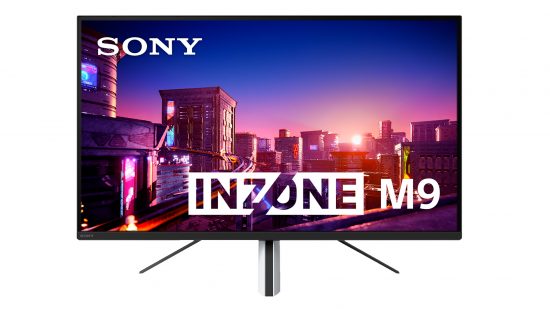
3. Sony Inzone M9
The best cross-platform 4K gaming monitor
Sony Inzone M9 specs:
| Screen | 27-inch IPS |
| Refresh rate | 144Hz |
| Connectivity | 2x HDMI 2.1 Display port 1.4 (DSC) USB Type-C 3x USB Type-A |
| Speakers | 2x 2 watts |
| Dimensions w/ stand | 24.21 x 18.86 x 9.76 in (61.5 x 47.9 x 24.8 cm) |
| Dimensions w/0 stand | 24.21 x 14.29 x 2.87 in (61.5 x 36.3 x 7.3 cm) |
| Weight | 14.99 lbs (6.8 kg) |
Pros:
- Stunning image quality
- HDMI 2.1 support
- Stylish, minimalist design
Cons:
- Expensive
- Poor internal speakers
- Wacky stand
Sony’s Inzone M9 was the company’s first 4k gaming monitor and is the sister model to the cheaper M3, which shares some features but lacks the picture-enhancing technology of the M9. Measuring 27 inches across the diagonal, this slim-bezel, low-profile panel is reminiscent of Sony’s Bravia TV range.
When we tested the Inzone M9 we found it to be well equipped, with three USB-A connections, two HDMI 2.1 ports, a DisplayPort connection and a USB-C socket, making it easy to connect to laptops and power external devices.
The panel produces vibrant, rich colours in both SDR and HDR trim. Accuracy and brightness are up there with the best in class, and the screen features several presets tuned for gamers alongside a cinema mode. There’s no noticeable ghosting or motion blur, but should you encounter any, the M9 allows you to increase the response time from ‘Standard’ to ‘Fast’ to alleviate any issues. As we’ve come to expect from IPS panels, the viewing angle is plenty wide, but blacks occasionally look a touch grey, particularly in low-light conditions.
HDMI 2.1 support is included, as is support for both FreeSync and G-Sync. This monitor is part of Sony’s ‘Perfect for PS5’ lineup, so alongside its PC gaming credentials, PS5 gamers and their Xbox Series X compatriots can make the most of the monitor’s gaming credentials. Like the Gigabyte M28U, the INZONE M9 has two integrated speakers. Performance, however, is below par and defaulting to an external speaker system is definitely encouraged.
The M9 looks great on first inspection, but take a closer look, and you’ll spot a lot of plastic in play. The M9’s stand is stylish but lacks adjustability. It’s slanted, so lowering the panel moves it towards you and raising it moves it further away. The monitor is VESA-compatible, however, so you can fix that. However, at this price point, you really shouldn’t have to.
The Sony INZONE M9 is a superb panel that does almost everything right but with a few caveats. It doesn’t come with any cables – which is a bit cheap considering the premium price point – and whether or not you’ll love it largely depends on whether you can bear its cost and deal with its minor idiosyncrasies.
Read our Sony Inzone M9 review.
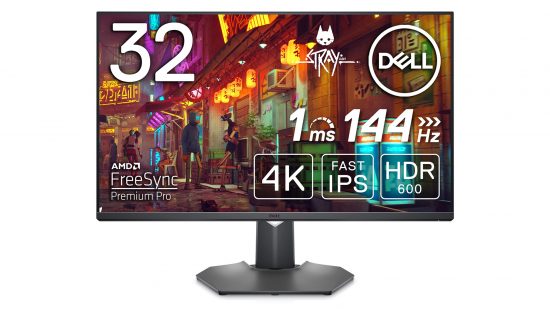
4. Dell G3223Q
The best all-round 4K gaming monitor
Dell G3223Q specs:
| Screen | 32-inch Fast IPS |
| Refresh rate | 144Hz |
| Connectivity | 2x HDMI 2.1 Display port 1.4 (DSC) 3x USB Type-A |
| Speakers | No |
| Dimensions w/ stand | 28.6 x 18.07 9.7 in (72.6 x 45.9 x 24.64 cm) |
| Dimensions w/o stand | 28.6 x 16.8 x 2.7 in (72.6 x 42.7 x 6.86 cm) |
| Weight | 13.29 lbs (6.03 kg) |
Pros:
- G-Sync and FreeSync compatible
- HDMI 2.1 support
- Great performance vs. price
Cons:
- No USB-C port
- Unexceptional looks
- No speakers
As the owner of the Alienware brand, you’d expect Dell to know a thing or two about gaming peripherals and that’s borne out by the G3223Q. Dell has given no quarter in its pursuit of 4K gaming monitor perfection.
It’s a brilliant 4K gaming offering with a 32-inch Fast IPS panel, low input lag and supremely balanced response times and motion resolution. It operates at a maximum 144Hz refresh rate and, despite its insanely reasonable price tag, it supports both AMD FreeSync and Nvidia G-Sync technologies. It doesn’t stop there either, with two HDMI 2.1 connections thrown in for good measure and DisplayPort compatibility alongside a host of USB connection connections.
Colour accuracy is excellent, and the viewing angle is also unnaturally wide. The downside comes in the form of the usual IPS gripes of slightly sub-par contrast and grey-ish blacks.
These minor criticisms aside, the G3223Q is one of the finest 4k gaming monitors we’ve come across at this price point. Styling is functional rather than spectacular, and there’s nothing here that screams gaming powerhouse. It’s a sleeper in gaming monitor terms. However, with a sleeve full of tricks – and barring the omission of USB-C – the Dell has all bases covered and is a near-perfect combination of price, performance and connectivity.
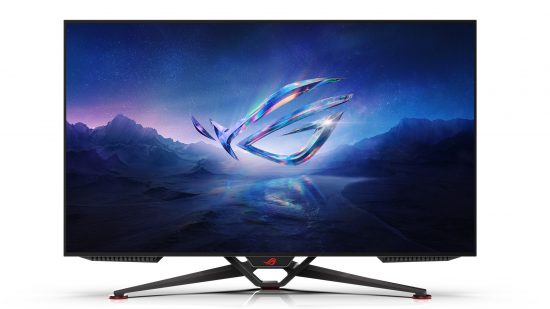
5. Asus ROG Swift PG42UQ
The best OLED 4K gaming monitor
Asus ROG Swift PG42UQ specs:
| Screen | 42-inch OLED |
| Refresh rate | 138Hz (overclocked) |
| Connectivity | 2x HDMI 2.1 2x HDMI 2.0 Display port 1.4 (DSC) 4x USB Type-A |
| Speakers | 2x 10 watts 15-watt subwoofer |
| Dimensions w/ stand | 36.7 x 24.06 x 10.06 in (93.2 x 61.13 x 25.54 cm) |
| Dimensions w/o stand | 36.7 x 21.73 x 1.47 in (93.2 x 55.2 x 3.74 cm) |
| Weight | 32.56 lbs (14.77 kg) |
Pros:
- Deep, rich colours and strong blacks
- Superb motion processing
- Good speakers
Cons:
- Very expensive
- No USB-C
- No height or swivel adjustment
While OLED screens aren’t quite ready to challenge the IPS status quo, we’re starting to see them entering the market. Despite an eye-watering price tag, the Asus makes a convincing argument for accelerating the jump to OLED from IPS.
The Asus outputs 4K with an overclocked 138Hz refresh rate and supports adaptive sync and the HDR 10 standard. It’s worth noting that OLED has its advantages and disadvantages over IPS. Faster refresh rates and bold, vivid colours are the stock in trade for IPS LCD panels, while OLED tends to offer better contrast and deeper blacks but can also suffer from burn-in if left displaying static images for too long.
The 42-inch panel in the Asus is a cracker, and that overclocked refresh rate gives it an edge over other 4K OLEDs, which top out at 120Hz. In addition, the claimed response time is just 0.1ms, making motion blur a non-issue. Given that figure, motion processing is super-smooth, and the panel delivers superb colours, contrast and brightness. Connectivity comes in the form of four HDMI ports, two of which are HDMI 2.1 for compatibility with the PS5 and Xbox Series X.
For once, we can talk about a set of internal monitor speakers delivering decent sound. Given the panel’s size, Asus has been able to give its OLED a punched-up sound system that’ll give most TVs a run for their money.
The screen’s super-slim bezel gives it an aesthetic edge over the IPS competition, and the monitor is VESA compatible, so if you prefer something a little more stylish than the sturdy supplied stand, you’ll be spoilt for choice.
This is an astonishingly good gaming monitor. If you can stomach the gut-wrenching price tag – and that may well drop considerably in the near future – and you have the desk or wall real estate available, then the PG42UQ is a near-faultless option for UHD gaming.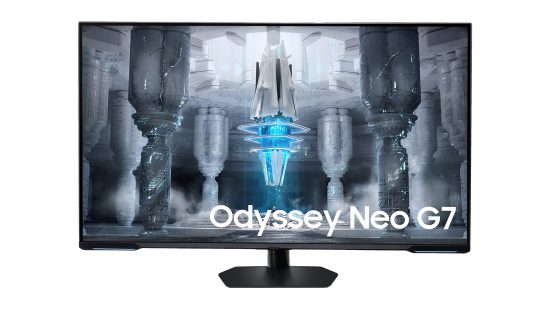
6. Samsung Odyssey Neo G7
The best 43-inch gaming monitor
Samsung Odyssey Neo G7 specs:
| Screen | 43-inch Quantum Mini LED |
| Refresh rate | 144Hz |
| Connectivity | 2x HDMI 2.1 Display port 1.4 (DSC) 2x USB 3.0 WiFi5 Bluetooth 5.2 Ethernet LAN |
| Speakers | 2x 20 w |
| Dimensions w/ stand | 37.83 x 25 x 10 in (96.1 x 63.5 x 25.41 cm) |
| Dimensions w/ o stand | 37.83 x 22.17 x 1.49 in (96.1 x 56.3 x 3.79 cm) |
| Weight | 25.8 lbs (11.7 kg) |
Pros:
- Deep, rich colours and strong blacks
- Superb motion processing
- Sharp design
Cons:
- No USB-C
- No tilt or swivel
- Poor speakers
The hulking 43-inch Samsung Odyssey Neo G7 is packing the brand’s Quantum Mini LED panel to boost picture quality.
The Mini LED panel is a step up from most IPS screens in terms of contrast, brightness and the depth of the blacks it renders. Colours are vibrant, and there’s no detectable ghosting or screen tearing in even the most demanding games. AMD’s FreeSync Premium Pro is catered for, but G-Sync is absent.
Connectivity is solid with two HDMI 2.1 ports, a display point 1.4 connection and two standard USB-A ports, but it lacks USB-C. The Neo G7 is the only monitor here to feature built-in WiFi, so it can connect to the internet and run streaming apps without connecting to a PC. It also includes Bluetooth and an Ethernet connection to maximise network speeds.
Samsung’s Game Bar 2.0 also makes an appearance, allowing you to check monitor speed settings, such as FPS and refresh rate, to ensure you’re getting the most out of the display without diving into full-screen menus.
It’s a modern, stylish monitor, bypassing some gaming devices’ RGB lighting and garish styling, but it’s also a beast, both in size and weight terms, weighing in at 11.7 kg. It’s still lighter than Asus’s OLED heavyweight champ, however. Sadly, the stand will only tilt forward and backwards; there’s no swivel or height adjustment. Given its size, a wall mount seems sensible unless you have the necessary desk space on hand, of course.
Like the Asus OLED, the Odyssey has built-in speakers, but unlike its nearest rival, performance is humdrum, and you’d be better served looking for an external speaker system to connect it to.
The Neo G7 offers excellent value for money, and its visual performance is superb. Mini LED addresses some of the issues of both OLED and IPS. Whether it does enough to shift focus away from the incoming OLED screens is another matter.
How we chose the best 4K gaming monitors
With 4K gaming monitors becoming more and more popular and inexpensive, there are a lot of options to choose from. We chose our picks based on these criteria:
- Price: 4K gaming monitors can be expensive. Prices have tumbled over the past few years, however, so there’s never been a better time to take the plunge. We chose monitors across a variety of price points.
- Screen: We’ve included IPS, OLED and Mini LED monitors. Each has its own strengths and weaknesses when it comes to contrast, colours, refresh rates and viewing angles.
- Size: Size matters. Are you prepared to sacrifice your budget for extra screen real estate? We’ve chosen our monitors in a variety of different sizes to suit your desk and your budget.
- Connectivity: When you’re spending big money on a new screen, you’ll want the flexibility to connect it to as many different devices as possible. We’re looking for USB-C, HDMI 2.1 and as many ports and sockets as we can lay our hands on.
Panel tech: IPS vs. OLED vs. Mini LED
With OLED screens finally making their presence felt in the 4K gaming monitor market and Mini LED options available, there’s more choice than ever before. IPS panels offer certain advantages over OLED and Mini LED, such as viewing angle and richer colours, while OLED and Mini LED offer better contrast and deeper blacks. OLED stands alone in terms of super-fast response times, however.
What are G-Sync and FreeSync?
AMD has its FreeSync open standard which is free for manufacturers to integrate into their products and Nvidia has its G-Sync technology, which is a paid-for standard and will therefore push up the price of an equipped monitor. Both technologies monitor frame rate and adjust GPU output to minimise stuttering and screen tearing.
